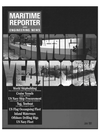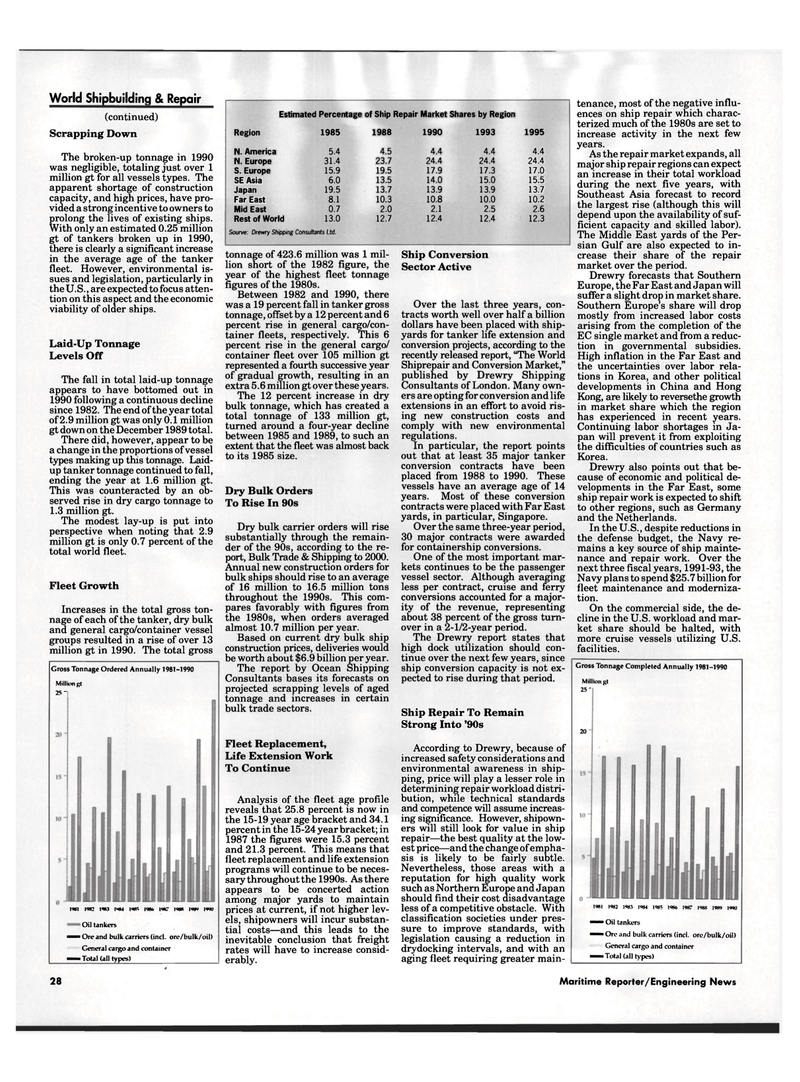
Page 26: of Maritime Reporter Magazine (June 1991)
Read this page in Pdf, Flash or Html5 edition of June 1991 Maritime Reporter Magazine
World Shipbuilding & Repair (continued)
Scrapping Down
The broken-up tonnage in 1990 was negligible, totaling just over 1 million gt for all vessels types. The apparent shortage of construction capacity, and high prices, have pro- vided a strong incentive to owners to prolong the lives of existing ships.
With only an estimated 0.25 million gt of tankers broken up in 1990, there is clearly a significant increase in the average age of the tanker fleet. However, environmental is- sues and legislation, particularly in the U.S., are expected to focus atten- tion on this aspect and the economic viability of older ships.
Laid-Up Tonnage
Levels Off
The fall in total laid-up tonnage appears to have bottomed out in 1990 following a continuous decline since 1982. The end of the year total of 2.9 million gt was only 0.1 million gt down on the December 1989 total.
There did, however, appear to be a change in the proportions of vessel types making up this tonnage. Laid- up tanker tonnage continued to fall, ending the year at 1.6 million gt.
This was counteracted by an ob- served rise in dry cargo tonnage to 1.3 million gt.
The modest lay-up is put into perspective when noting that 2.9 million gt is only 0.7 percent of the total world fleet.
Fleet Growth
Increases in the total gross ton- nage of each of the tanker, dry bulk and general cargo/container vessel groups resulted in a rise of over 13 million gt in 1990. The total gross
Cross Tonnage Ordered Annually 1981-1990
Million gt 25 1
Estimated Percentage of Ship Repair Market Shares by Region
Region 1985 1988 1990 1993 1995
N. America 5.4 4.5 4.4 4.4 4.4
N. Europe 31.4 23.7 24.4 24.4 24.4
S. Europe 15.9 19.5 17.9 17.3 17.0
SE Asia 6.0 13.5 14.0 15.0 15.5
Japan 19.5 13.7 13.9 13.9 13.7
Far East 8.1 10.3 10.8 10.0 10.2
Mid East 0.7 2.0 2.1 2.5 2.6
Rest of World 13.0 12.7 12.4 12.4 12.3
Sourve: Drewry Shipping Consultants Ltd.
!»! I9S2 1**3 1«M MB I9S6 ! Oil tankers
•"""« Ore and bulk carriers (incl. ore/bulk/oil)
General cargo and container
— Total (all types)
tonnage of 423.6 million was 1 mil-
lion short of the 1982 figure, the
year of the highest fleet tonnage
figures of the 1980s.
Between 1982 and 1990, there
was a 19 percent fall in tanker gross
tonnage, offset by a 12 percent and 6
percent rise in general cargo/con-
tainer fleets, respectively. This 6
percent rise in the general cargo/
container fleet over 105 million gt
represented a fourth successive year
of gradual growth, resulting in an
extra 5.6 million gt over these years.
The 12 percent increase in dry
bulk tonnage, which has created a
total tonnage of 133 million gt,
turned around a four-year decline
between 1985 and 1989, to such an
extent that the fleet was almost back
to its 1985 size.
Dry Bulk Orders
To Rise In 90s
Dry bulk carrier orders will rise
substantially through the remain-
der of the 90s, according to the re-
port, Bulk Trade & Shipping to 2000.
Annual new construction orders for
bulk ships should rise to an average
of 16 million to 16.5 million tons
throughout the 1990s. This com-
pares favorably with figures from
the 1980s, when orders averaged
almost 10.7 million per year.
Based on current dry bulk ship
construction prices, deliveries would
be worth about $6.9 billion per year.
The report by Ocean Shipping
Consultants bases its forecasts on
projected scrapping levels of aged
tonnage and increases in certain
bulk trade sectors.
Fleet Replacement,
Life Extension Work
To Continue
Analysis of the fleet age profile
reveals that 25.8 percent is now in
the 15-19 year age bracket and 34.1
percent in the 15-24 year bracket; in
1987 the figures were 15.3 percent
and 21.3 percent. This means that
fleet replacement and life extension
programs will continue to be neces-
sary throughout the 1990s. As there
appears to be concerted action
among major yards to maintain
prices at current, if not higher lev-
els, shipowners will incur substan-
tial costs—and this leads to the
inevitable conclusion that freight
rates will have to increase consid-
erably.
Ship Conversion
Sector Active
Over the last three years, con-
tracts worth well over half a billion
dollars have been placed with ship-
yards for tanker life extension and
conversion projects, according to the
recently released report, "The World
Shiprepair and Conversion Market,"
published by Drewry Shipping
Consultants of London. Many own-
ers are opting for conversion and life
extensions in an effort to avoid ris-
ing new construction costs and
comply with new environmental
regulations.
In particular, the report points
out that at least 35 major tanker
conversion contracts have been
placed from 1988 to 1990. These
vessels have an average age of 14
years. Most of these conversion
contracts were placed with Far East
yards, in particular, Singapore.
Over the same three-year period,
30 major contracts were awarded
for containership conversions.
One of the most important mar-
kets continues to be the passenger
vessel sector. Although averaging
less per contract, cruise and ferry
conversions accounted for a major-
ity of the revenue, representing
about 38 percent of the gross turn-
over in a 2-1/2-year period.
The Drewry report states that
high dock utilization should con-
tinue over the next few years, since
ship conversion capacity is not ex-
pected to rise during that period.
Ship Repair To Remain
Strong Into '90s
According to Drewry, because of
increased safety considerations and
environmental awareness in ship-
ping, price will play a lesser role in
determining repair workload distri-
bution, while technical standards
and competence will assume increas-
ing significance. However, shipown-
ers will still look for value in ship
repair—the best quality at the low-
est price—and the change of empha-
sis is likely to be fairly subtle.
Nevertheless, those areas with a
reputation for high quality work
such as Northern Europe and Japan
should find their cost disadvantage
less of a competitive obstacle. With
classification societies under pres-
sure to improve standards, with
legislation causing a reduction in
drydocking intervals, and with an
aging fleet requiring greater main-
tenance, most of the negative influ-
ences on ship repair which charac-
terized much of the 1980s are set to
increase activity in the next few
years.
As the repair market expands, all
major ship repair regions can expect
an increase in their total workload
during the next five years, with
Southeast Asia forecast to record
the largest rise (although this will
depend upon the availability of suf-
ficient capacity and skilled labor).
The Middle East yards of the Per-
sian Gulf are also expected to in-
crease their share of the repair
market over the period.
Drewry forecasts that Southern
Europe, the Far East and Japan will
suffer a slight drop in market share.
Southern Europe's share will drop
mostly from increased labor costs
arising from the completion of the
EC single market and from a reduc-
tion in governmental subsidies.
High inflation in the Far East and
the uncertainties over labor rela-
tions in Korea, and other political
developments in China and Hong
Kong, are likely to reversethe growth
in market share which the region
has experienced in recent years.
Continuing labor shortages in Ja-
pan will prevent it from exploiting
the difficulties of countries such as
Korea.
Drewry also points out that be-
cause of economic and political de-
velopments in the Far East, some
ship repair work is expected to shift
to other regions, such as Germany
and the Netherlands.
In the U.S., despite reductions in
the defense budget, the Navy re-
mains a key source of ship mainte-
nance and repair work. Over the
next three fiscal years, 1991-93, the
Navy plans to spend $25.7 billion for
fleet maintenance and moderniza-
tion.
On the commercial side, the de-
cline in the U.S. workload and mar-
ket share should be halted, with
more cruise vessels utilizing U.S.
facilities.
Gross Tonnage Completed Annually 1981-1990
Million gt
25"
20
NSI 1982 1183 1984 1985 1186 1987 1988 1989 1990
mmm Oil tankers
— Ore and bulk carriers (incl. ore/bulk/oil)
General cargo and container
— Total (all types)
28 Maritime Reporter/Engineering News

 25
25

 27
27
